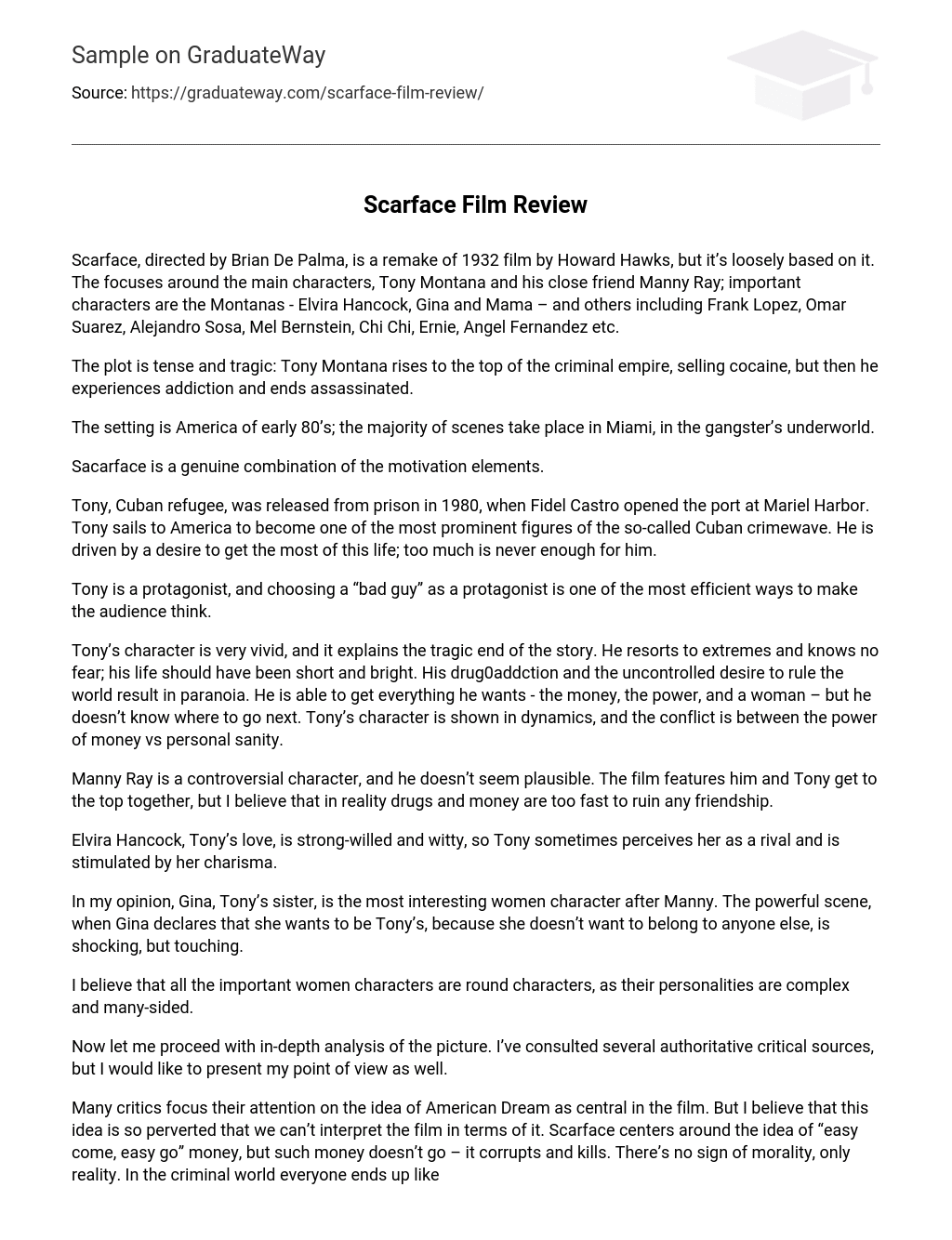Scarface, directed by Brian De Palma, is a remake of 1932 film by Howard Hawks, but it’s loosely based on it. The focuses around the main characters, Tony Montana and his close friend Manny Ray; important characters are the Montanas – Elvira Hancock, Gina and Mama – and others including Frank Lopez, Omar Suarez, Alejandro Sosa, Mel Bernstein, Chi Chi, Ernie, Angel Fernandez etc.
The plot is tense and tragic: Tony Montana rises to the top of the criminal empire, selling cocaine, but then he experiences addiction and ends assassinated.
The setting is America of early 80’s; the majority of scenes take place in Miami, in the gangster’s underworld.
Sacarface is a genuine combination of the motivation elements.
Tony, Cuban refugee, was released from prison in 1980, when Fidel Castro opened the port at Mariel Harbor. Tony sails to America to become one of the most prominent figures of the so-called Cuban crimewave. He is driven by a desire to get the most of this life; too much is never enough for him.
Tony is a protagonist, and choosing a “bad guy” as a protagonist is one of the most efficient ways to make the audience think.
Tony’s character is very vivid, and it explains the tragic end of the story. He resorts to extremes and knows no fear; his life should have been short and bright. His drug0addction and the uncontrolled desire to rule the world result in paranoia. He is able to get everything he wants – the money, the power, and a woman – but he doesn’t know where to go next. Tony’s character is shown in dynamics, and the conflict is between the power of money vs personal sanity.
Manny Ray is a controversial character, and he doesn’t seem plausible. The film features him and Tony get to the top together, but I believe that in reality drugs and money are too fast to ruin any friendship.
Elvira Hancock, Tony’s love, is strong-willed and witty, so Tony sometimes perceives her as a rival and is stimulated by her charisma.
In my opinion, Gina, Tony’s sister, is the most interesting women character after Manny. The powerful scene, when Gina declares that she wants to be Tony’s, because she doesn’t want to belong to anyone else, is shocking, but touching.
I believe that all the important women characters are round characters, as their personalities are complex and many-sided.
Now let me proceed with in-depth analysis of the picture. I’ve consulted several authoritative critical sources, but I would like to present my point of view as well.
Many critics focus their attention on the idea of American Dream as central in the film. But I believe that this idea is so perverted that we can’t interpret the film in terms of it. Scarface centers around the idea of “easy come, easy go” money, but such money doesn’t go – it corrupts and kills. There’s no sign of morality, only reality. In the criminal world everyone ends up like Tony Montana.
As Nick Hilditch, BBC film reviewer, notes, “this is very much a film of the 80s in its portrayal not of moral decline (there is little declining left to do) but of unstoppable ego-centrism.” (Hilditch 2001)
An attentive viewer will note numerous allusions with world literature. Some researchers tend to interpret Scarface as an Aristotelian tragedy. And a research article by Michael Cohen states the following:
“Like poor Oedipus, he attempts to control his own fate, to fight the forces that would tear him down, only to find that the prophetic narrative is one step ahead of him.” (Cohen 2001)
De Palma’s perfect direction gives an unusual picture of the culture of the drug lords; this film made a great contribution to the formation of cocaine aesthetics, which became dominant during late 80’s and early 90’s.
Profanity and violence sometime arouse disgust, but in the majority of cases we simply sympathise the characters trapped in their own lifestyle and illusion.
The imagery of the film is worth analysing. The X-shaped scar embodies and symbolise of death, so I would call the imagery of the film to be aggressive and assertive. De Palma made his film “expansive, passionate, stylized and cheerfully excessive, and yet he has never caved in to the demand for routine action thrillers.” (Ebert 2003)
To sum up, I would like to share personal impressions of the film and explain my choice. Scarface is different from the great number of gangster films produced in America in the late 20th century. Also it had a significant impact on the discourse and further development of the movie industry in general. Many phrases, for instance, “Say hello to my leetle friend,” became known all around the planet. The performance of Al Pacino and Michelle Pfeiffer is excellent. The screenplay was written by celebrated Oliver Stone; as a consequence it’s impossible to tear oneself away from this three-hour film. And finally, it is cinematography and camera work that made the film world classics.
References
Brian De Palma, dir., Scarface, Universal Studios, 1983
Cohen, M., 2001, Scarface
http://www.sensesofcinema.com/contents/cteq/01/12/scarface.html
(Last accessed: 9 Oct 2004)
Hilditch, N., 2001, Scarface, BBC film review
http://www.bbc.co.uk/films/2001/02/08/scarface_1983_review.shtml
(Last accessed: 9 Oct 2004)
Ebert, R., 2003, Scarface, Chicago Sun-Times
http://www.suntimes.com/ebert/greatmovies/scarface.html
(Last accessed: 9 Oct 2004)





